check engine Ram ProMaster 2014 Owner's Guide
[x] Cancel search | Manufacturer: RAM, Model Year: 2014, Model line: ProMaster, Model: Ram ProMaster 2014Pages: 410, PDF Size: 2.83 MB
Page 326 of 410

Your vehicle has a simple ignition actuated test, which
you can use prior to going to the test station. To check if
your vehicle’s OBD II system is ready, you must do the
following:
1. Cycle the ignition switch to the ON position, but donot crank or start the engine.
NOTE: If you crank or start the engine, you will have to
start this test over.
2. As soon as you cycle the ignition switch to the ON position, you will see the MIL symbol come on as part
of a normal bulb check.
3. Approximately 15 seconds later, one of two things will happen:
• The MIL will flash for about 10 seconds and then
return to being fully illuminated until you turn OFF
the ignition or start the engine. This means that your
vehicle’s OBD II system is not readyand you should
not proceed to the I/M station. •
The MIL will not flash at all and will remain fully
illuminated until you turn OFF the ignition or start the
engine. This means that your vehicle’s OBD II system
is ready and you can proceed to the I/M station.
If your OBD II system is not ready,you should see your
authorized dealer or repair facility. If your vehicle was
recently serviced or had a battery failure or replacement,
you may need to do nothing more than drive your
vehicle as you normally would in order for your OBD II
system to update. A recheck with the above test routine
may then indicate that the system is now ready.
Regardless of whether your vehicle’s OBD II system is
ready or not, if the MIL is illuminated during normal
vehicle operation you should have your vehicle serviced
before going to the I/M station. The I/M station can fail
your vehicle because the MIL is on with the engine
running.
324 MAINTAINING YOUR VEHICLE
Page 329 of 410
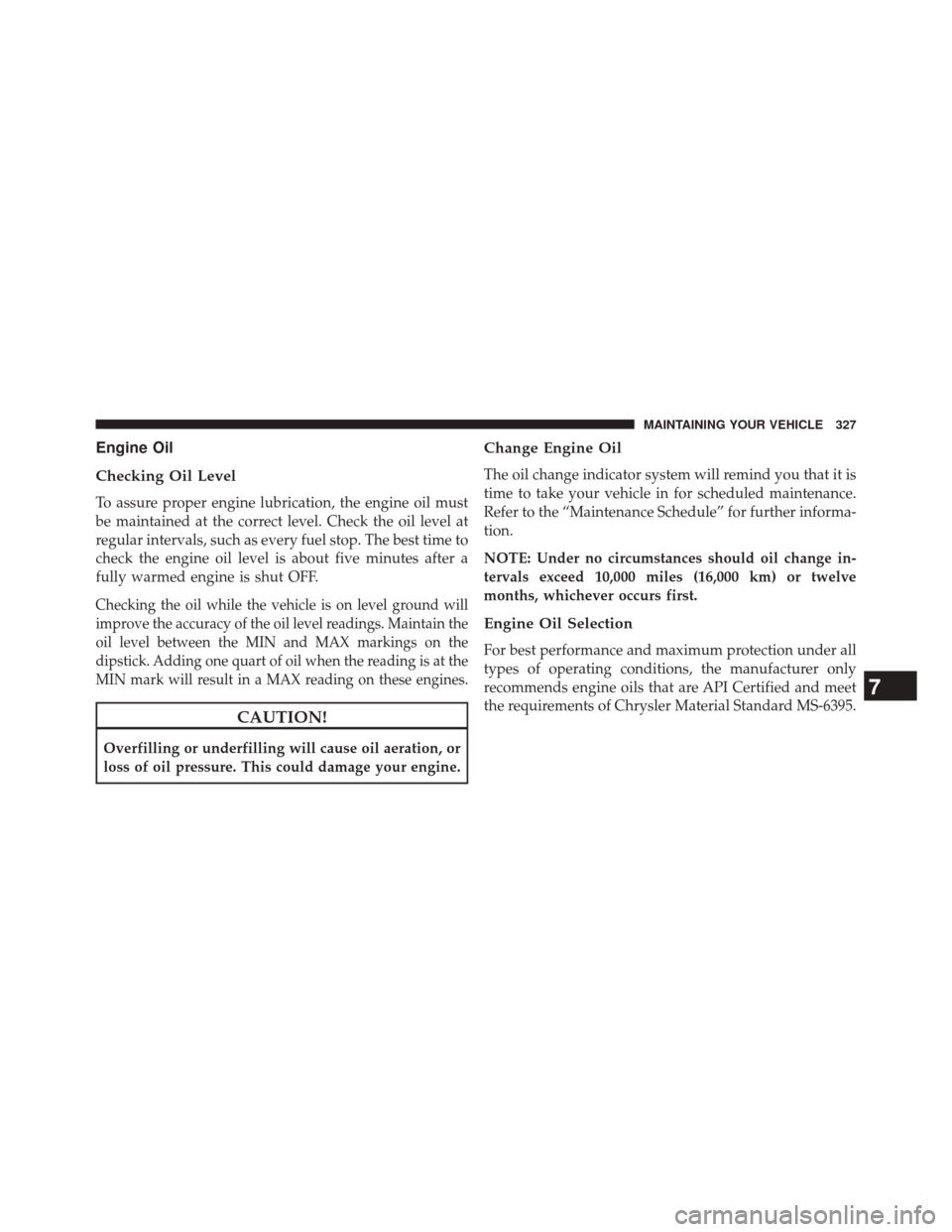
Engine Oil
Checking Oil Level
To assure proper engine lubrication, the engine oil must
be maintained at the correct level. Check the oil level at
regular intervals, such as every fuel stop. The best time to
check the engine oil level is about five minutes after a
fully warmed engine is shut OFF.
Checking the oil while the vehicle is on level ground will
improve the accuracy of the oil level readings. Maintain the
oil level between the MIN and MAX markings on the
dipstick. Adding one quart of oil when the reading is at the
MIN mark will result in a MAX reading on these engines.
CAUTION!
Overfilling or underfilling will cause oil aeration, or
loss of oil pressure. This could damage your engine.
Change Engine Oil
The oil change indicator system will remind you that it is
time to take your vehicle in for scheduled maintenance.
Refer to the “Maintenance Schedule” for further informa-
tion.
NOTE: Under no circumstances should oil change in-
tervals exceed 10,000 miles (16,000 km) or twelve
months, whichever occurs first.
Engine Oil Selection
For best performance and maximum protection under all
types of operating conditions, the manufacturer only
recommends engine oils that are API Certified and meet
the requirements of Chrysler Material Standard MS-6395.
7
MAINTAINING YOUR VEHICLE 327
Page 339 of 410
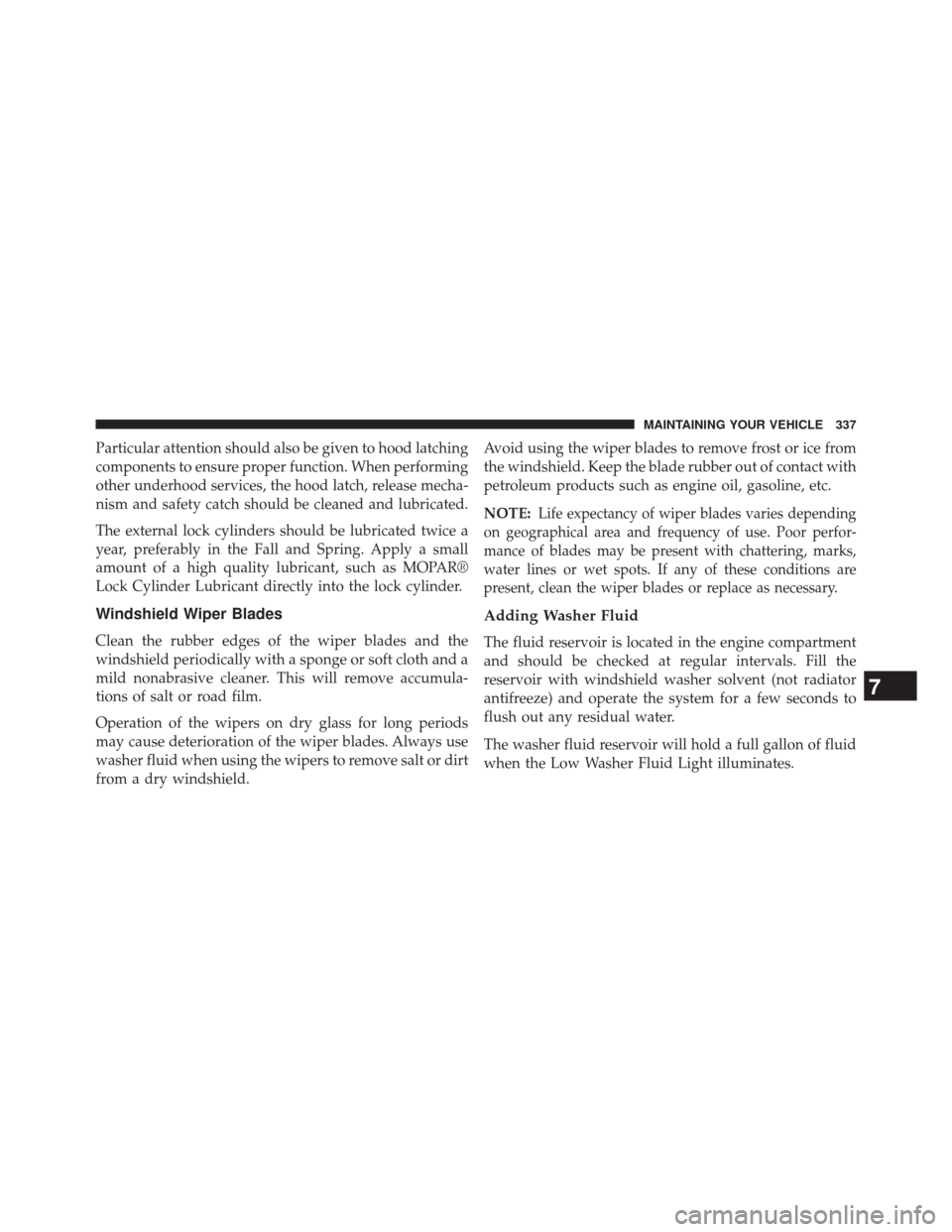
Particular attention should also be given to hood latching
components to ensure proper function. When performing
other underhood services, the hood latch, release mecha-
nism and safety catch should be cleaned and lubricated.
The external lock cylinders should be lubricated twice a
year, preferably in the Fall and Spring. Apply a small
amount of a high quality lubricant, such as MOPAR®
Lock Cylinder Lubricant directly into the lock cylinder.
Windshield Wiper Blades
Clean the rubber edges of the wiper blades and the
windshield periodically with a sponge or soft cloth and a
mild nonabrasive cleaner. This will remove accumula-
tions of salt or road film.
Operation of the wipers on dry glass for long periods
may cause deterioration of the wiper blades. Always use
washer fluid when using the wipers to remove salt or dirt
from a dry windshield.Avoid using the wiper blades to remove frost or ice from
the windshield. Keep the blade rubber out of contact with
petroleum products such as engine oil, gasoline, etc.
NOTE:
Life expectancy of wiper blades varies depending
on geographical area and frequency of use. Poor perfor-
mance of blades may be present with chattering, marks,
water lines or wet spots. If any of these conditions are
present, clean the wiper blades or replace as necessary.
Adding Washer Fluid
The fluid reservoir is located in the engine compartment
and should be checked at regular intervals. Fill the
reservoir with windshield washer solvent (not radiator
antifreeze) and operate the system for a few seconds to
flush out any residual water.
The washer fluid reservoir will hold a full gallon of fluid
when the Low Washer Fluid Light illuminates.
7
MAINTAINING YOUR VEHICLE 337
Page 341 of 410

Coolant Checks
Check the engine coolant (antifreeze) protection every
12 months (before the onset of freezing weather, where
applicable). If the engine coolant (antifreeze) is dirty, the
system should be drained, flushed, and refilled with
fresh OAT coolant (conforming to MS-12106) only by an
authorized dealer. Check the front of the A/C condenser
for any accumulation of bugs, leaves, etc. If dirty, clean by
gently spraying water from a garden hose vertically
down the face of the condenser.
Cooling System — Drain, Flush And Refill
If the engine coolant (antifreeze) is dirty or contains
visible sediment, have an authorized dealer clean
and flush with OAT coolant (antifreeze) (conforming to
MS-12106).Refer to the “Maintenance Schedule” for the proper
maintenance intervals.
NOTE:
Some vehicles require special tools to add coolant
properly. Failure to fill these systems properly could lead
to severe internal engine damage. If any coolant is
needed to be added to the system please contact your
local authorized dealer.
Selection Of Coolant
Refer to “Fluids, Lubricants, and Genuine Parts” in
“Maintaining Your Vehicle” for further information.
7
MAINTAINING YOUR VEHICLE 339
Page 345 of 410
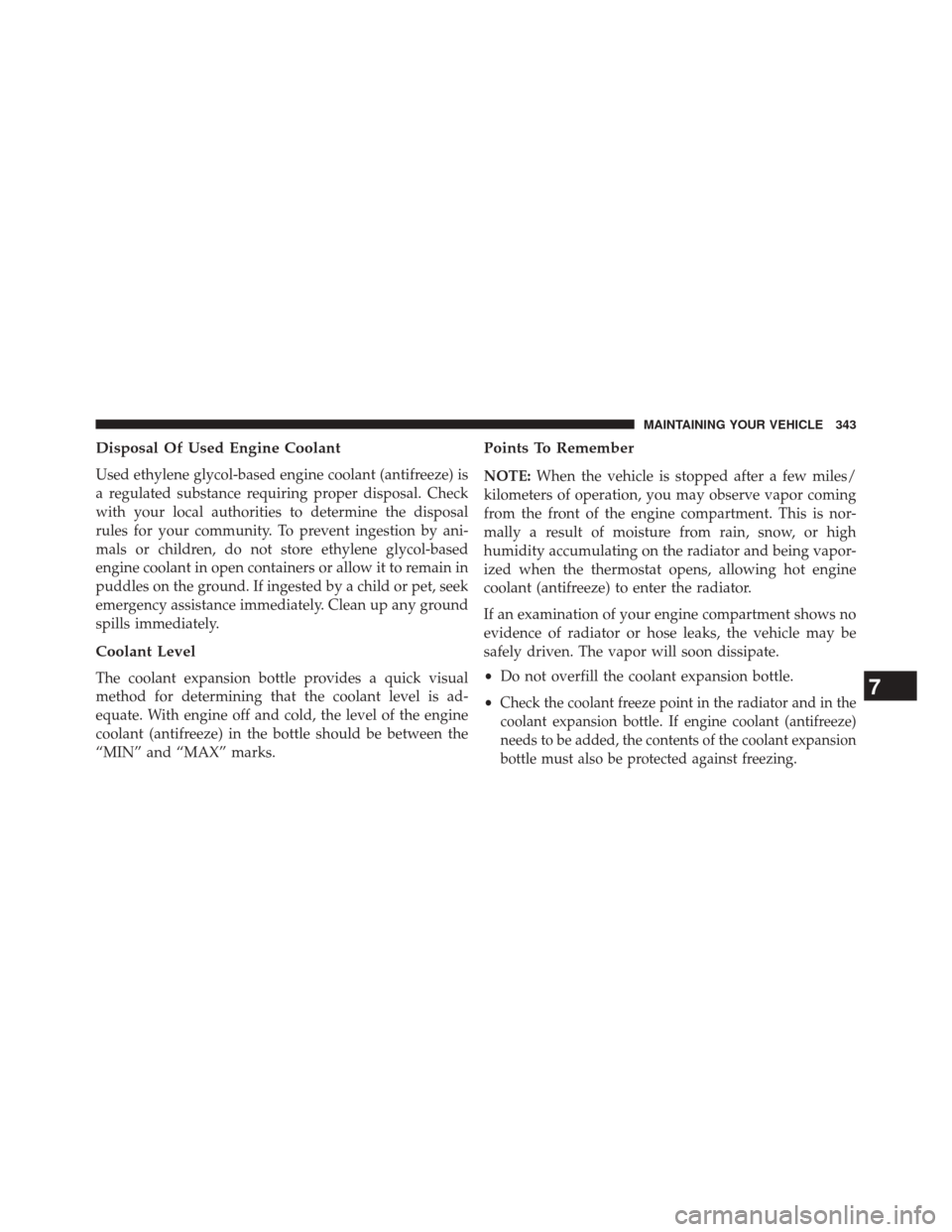
Disposal Of Used Engine Coolant
Used ethylene glycol-based engine coolant (antifreeze) is
a regulated substance requiring proper disposal. Check
with your local authorities to determine the disposal
rules for your community. To prevent ingestion by ani-
mals or children, do not store ethylene glycol-based
engine coolant in open containers or allow it to remain in
puddles on the ground. If ingested by a child or pet, seek
emergency assistance immediately. Clean up any ground
spills immediately.
Coolant Level
The coolant expansion bottle provides a quick visual
method for determining that the coolant level is ad-
equate. With engine off and cold, the level of the engine
coolant (antifreeze) in the bottle should be between the
“MIN” and “MAX” marks.
Points To Remember
NOTE:When the vehicle is stopped after a few miles/
kilometers of operation, you may observe vapor coming
from the front of the engine compartment. This is nor-
mally a result of moisture from rain, snow, or high
humidity accumulating on the radiator and being vapor-
ized when the thermostat opens, allowing hot engine
coolant (antifreeze) to enter the radiator.
If an examination of your engine compartment shows no
evidence of radiator or hose leaks, the vehicle may be
safely driven. The vapor will soon dissipate.
• Do not overfill the coolant expansion bottle.
•
Check the coolant freeze point in the radiator and in the
coolant expansion bottle. If engine coolant (antifreeze)
needs to be added, the contents of the coolant expansion
bottle must also be protected against freezing.7
MAINTAINING YOUR VEHICLE 343
Page 378 of 410
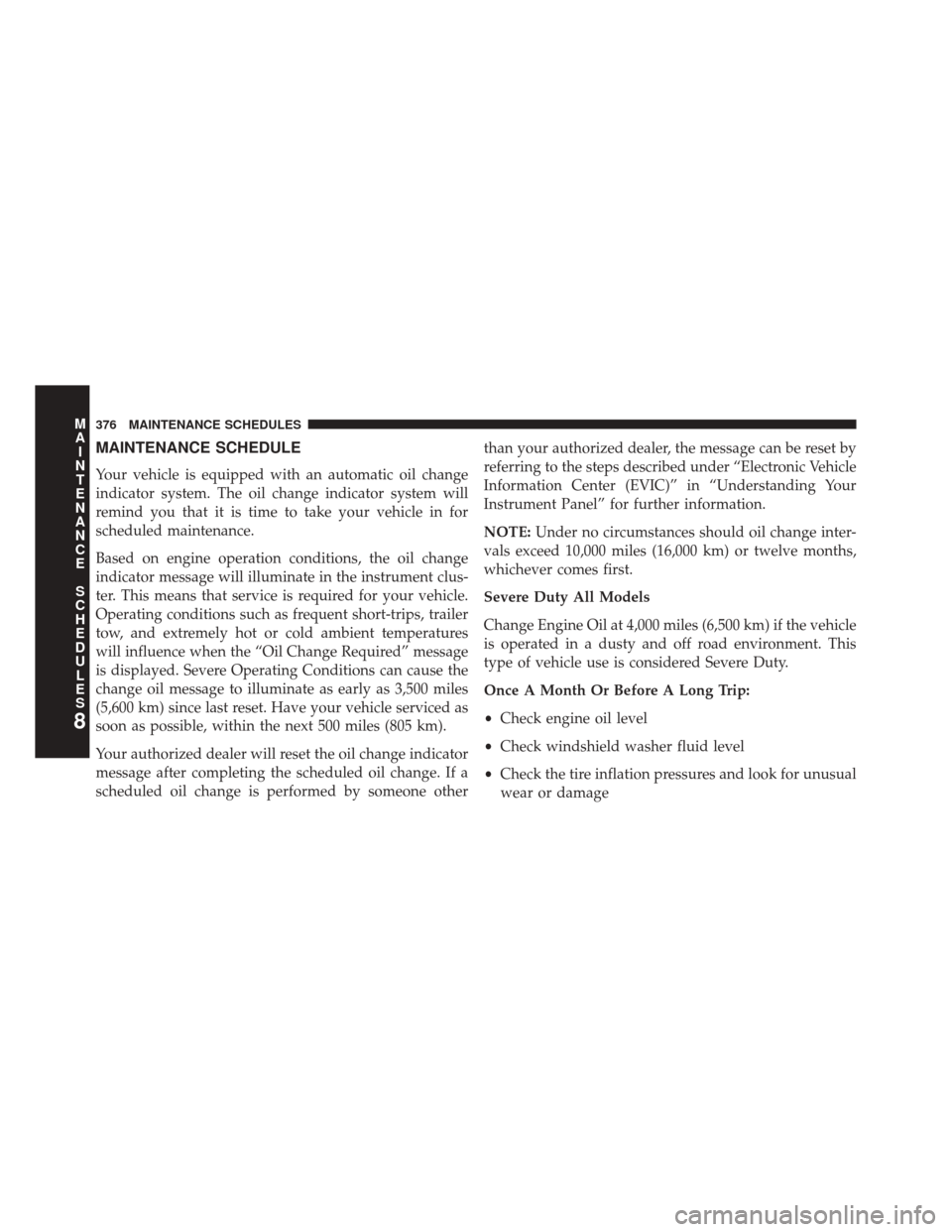
MAINTENANCE SCHEDULE
Your vehicle is equipped with an automatic oil change
indicator system. The oil change indicator system will
remind you that it is time to take your vehicle in for
scheduled maintenance.
Based on engine operation conditions, the oil change
indicator message will illuminate in the instrument clus-
ter. This means that service is required for your vehicle.
Operating conditions such as frequent short-trips, trailer
tow, and extremely hot or cold ambient temperatures
will influence when the “Oil Change Required” message
is displayed. Severe Operating Conditions can cause the
change oil message to illuminate as early as 3,500 miles
(5,600 km) since last reset. Have your vehicle serviced as
soon as possible, within the next 500 miles (805 km).
Your authorized dealer will reset the oil change indicator
message after completing the scheduled oil change. If a
scheduled oil change is performed by someone otherthan your authorized dealer, the message can be reset by
referring to the steps described under “Electronic Vehicle
Information Center (EVIC)” in “Understanding Your
Instrument Panel” for further information.
NOTE:
Under no circumstances should oil change inter-
vals exceed 10,000 miles (16,000 km) or twelve months,
whichever comes first.
Severe Duty All Models
Change Engine Oil at 4,000 miles (6,500 km) if the vehicle
is operated in a dusty and off road environment. This
type of vehicle use is considered Severe Duty.
Once A Month Or Before A Long Trip:
• Check engine oil level
• Check windshield washer fluid level
• Check the tire inflation pressures and look for unusual
wear or damage
8
M A I
N T
E
N
A
N
C E
S
C
H E
D
U L
E
S376 MAINTENANCE SCHEDULES
Page 379 of 410
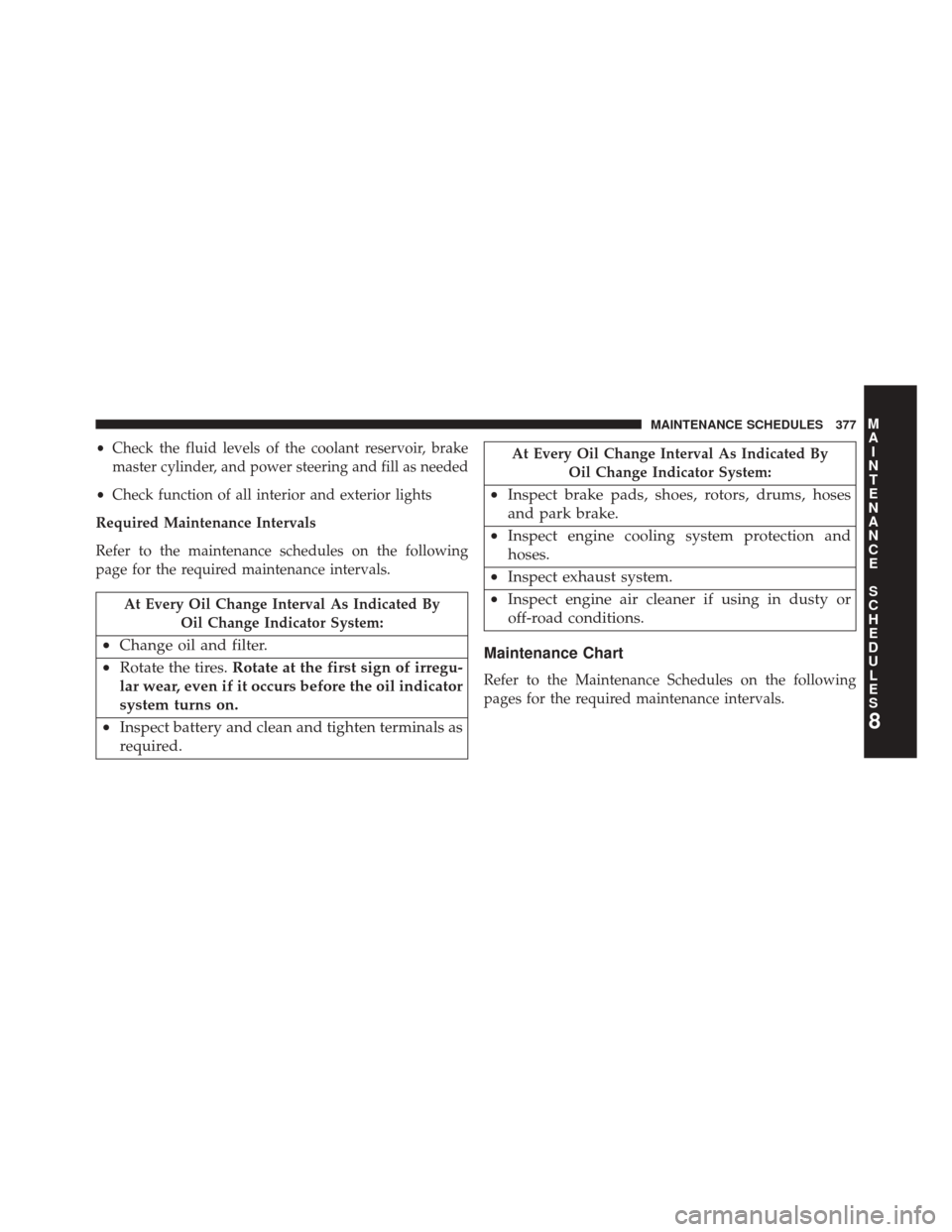
•Check the fluid levels of the coolant reservoir, brake
master cylinder, and power steering and fill as needed
• Check function of all interior and exterior lights
Required Maintenance Intervals
Refer to the maintenance schedules on the following
page for the required maintenance intervals.
At Every Oil Change Interval As Indicated By Oil Change Indicator System:
•Change oil and filter.
• Rotate the tires. Rotate at the first sign of irregu-
lar wear, even if it occurs before the oil indicator
system turns on.
• Inspect battery and clean and tighten terminals as
required.
At Every Oil Change Interval As Indicated By
Oil Change Indicator System:
•Inspect brake pads, shoes, rotors, drums, hoses
and park brake.
• Inspect engine cooling system protection and
hoses.
• Inspect exhaust system.
• Inspect engine air cleaner if using in dusty or
off-road conditions.
Maintenance Chart
Refer to the Maintenance Schedules on the following
pages for the required maintenance intervals.
8
M A I
N T
E
N
A
N
C E
S
C
H E
D
U L
E
SMAINTENANCE SCHEDULES 377
Page 394 of 410
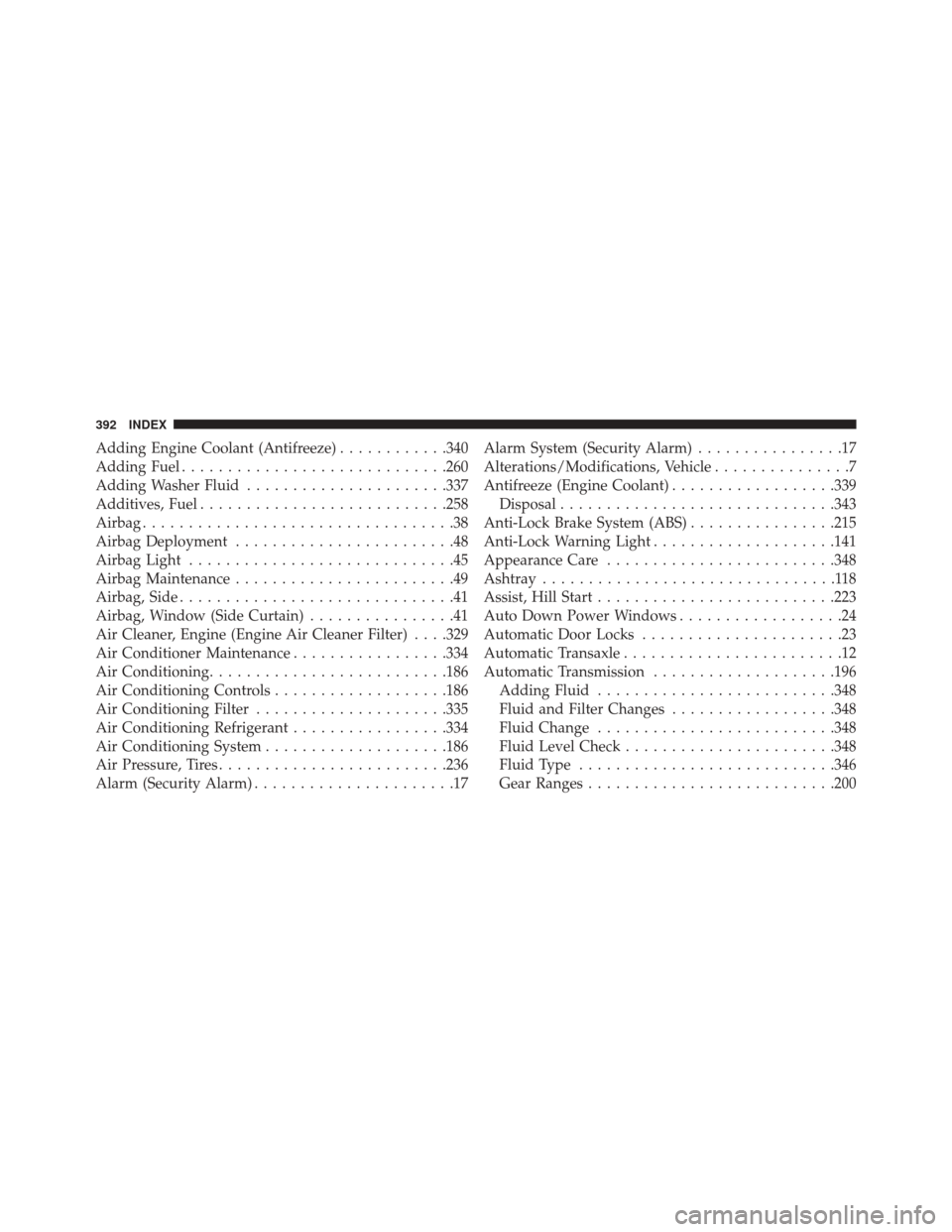
Adding Engine Coolant (Antifreeze)............340
Adding Fuel ............................ .260
Adding Washer Fluid ..................... .337
Additives, Fuel .......................... .258
Airbag ..................................38
Airbag Deployment ........................48
Airbag Light .............................45
Airbag Maintenance ........................49
Airbag, Side ..............................41
Airbag, Window (Side Curtain) ................41
Air Cleaner, Engine (Engine Air Cleaner Filter) . . . .329
Air Conditioner Maintenance .................334
Air Conditioning ......................... .186
Air Conditioning Controls ...................186
Air Conditioning Filter .....................335
Air Conditioning Refrigerant .................334
Air Conditioning System ....................186
Air Pressure, Tires ........................ .236
Alarm (Security Alarm) ......................17 Alarm System (Security Alarm)
................17
Alterations/Modifications, Vehicle ...............7
Antifreeze (Engine Coolant) ..................339
Disposal ............................. .343
Anti-Lock Brake System (ABS) ................215
Anti-Lock Warning Light ....................141
Appearance Care ........................ .348
Ashtray ................................118
Assist, Hill Start ......................... .223
Auto Down Power Windows ..................24
Automatic Door Locks ......................23
Automatic Transaxle ........................12
Automatic Transmission ....................196
Adding Fluid ......................... .348
Fluid and Filter Changes ..................348
Fluid Change ......................... .348
Fluid Level Check ...................... .348
Fluid Type ........................... .346
Gear Ranges .......................... .200
392 INDEX
Page 395 of 410
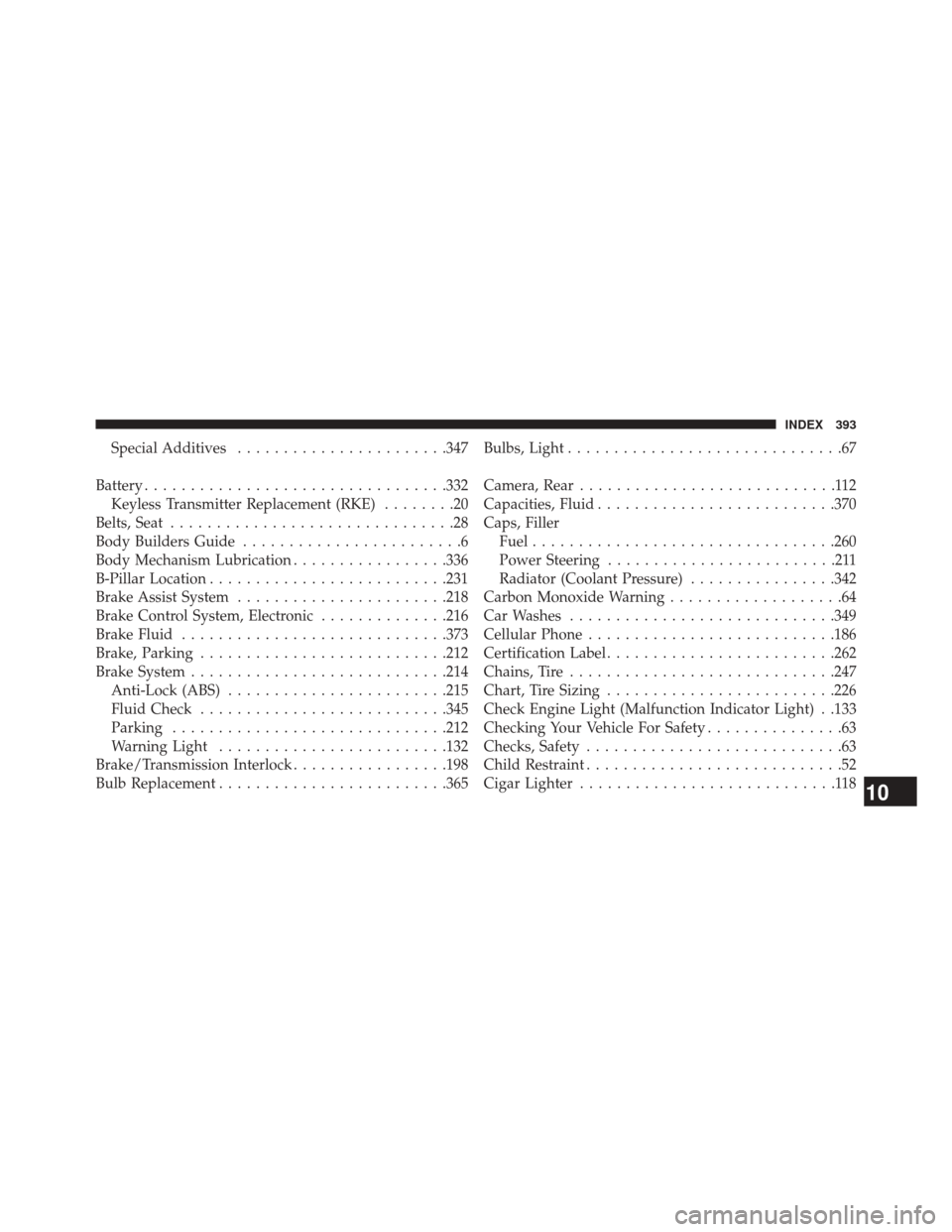
Special Additives...................... .347
Battery ................................ .332
Keyless Transmitter Replacement (RKE) ........20
Belts, Seat ...............................28
Body Builders Guide ........................6
Body Mechanism Lubrication .................336
B-Pillar Location ......................... .231
Brake Assist System ...................... .218
Brake Control System, Electronic ..............216
Brake Fluid ............................ .373
Brake, Parking .......................... .212
Brake System ........................... .214
Anti-Lock (ABS) ....................... .215
Fluid Check .......................... .345
Parking ............................. .212
Warning Light ........................ .132
Brake/Transmission Interlock .................198
Bulb Replacement ........................ .365Bulbs, Light
..............................67
Camera, Rear ............................112
Capacities, Fluid ......................... .370
Caps, Filler Fuel ................................ .260
Power Steering .........................211
Radiator (Coolant Pressure) ................342
Carbon Monoxide Warning ...................64
Car Washes ............................ .349
Cellular Phone .......................... .186
Certification Label ........................ .262
Chains, Tire ............................ .247
Chart, Tire Sizing ........................ .226
Check Engine Light (Malfunction Indicator Light) . .133
Checking Your Vehicle For Safety ...............63
Checks, Safety ............................63
Child Restraint ............................52
Cigar Lighter ............................118
10
INDEX 393
Page 397 of 410
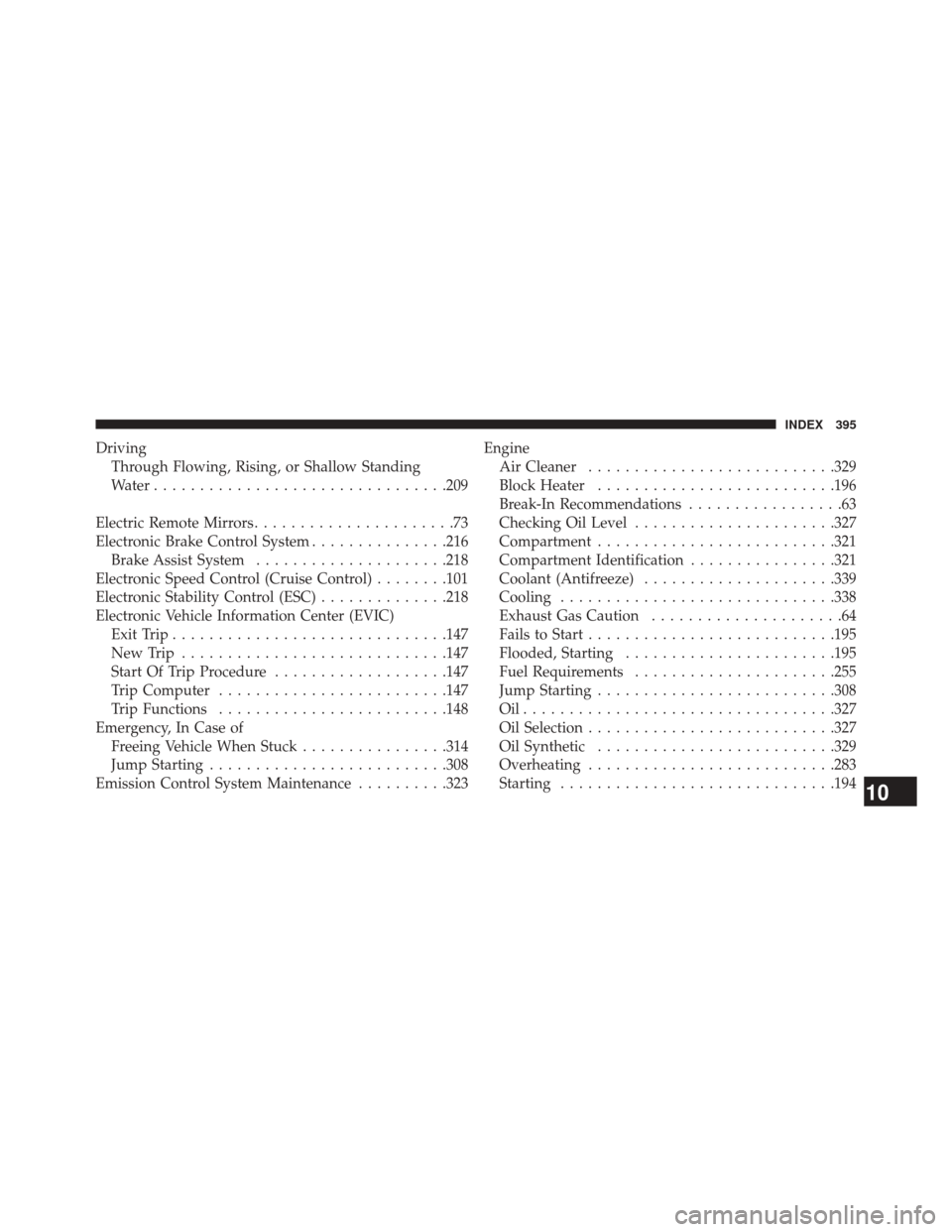
DrivingThrough Flowing, Rising, or Shallow Standing
Water ............................... .209
Electric Remote Mirrors ......................73
Electronic Brake Control System ...............216
Brake Assist System .....................218
Electronic Speed Control (Cruise Control) ........101
Electronic Stability Control (ESC) ..............218
Electronic Vehicle Information Center (EVIC) Exit Trip ............................. .147
NewTrip ............................ .147
Start Of Trip Procedure ...................147
Trip Computer ........................ .147
Trip Functions ........................ .148
Emergency, In Case of Freeing Vehicle When Stuck ................314
Jump Starting ......................... .308
Emission Control System Maintenance ..........323Engine
Air Cleaner .......................... .329
Block Heater ......................... .196
Break-In Recommendations .................63
Checking Oil Level ..................... .327
Compartment ......................... .321
Compartment Identification ................321
Coolant (Antifreeze) .....................339
Cooling ............................. .338
Exhaust Gas Caution .....................64
Fails to Start .......................... .195
Flooded, Starting ...................... .195
Fuel Requirements ..................... .255
Jump Starting ......................... .308
Oil................................. .327
Oil Selection .......................... .327
Oil Synthetic ......................... .329
Overheating .......................... .283
Starting ............................. .194
10
INDEX 395